Description
Trade name
of L-Цет®
the International unlicensed
name Levotsetirizin Lekarstvennaya
the Tablet form, film coated 5 mg
Structure
One tablet contains
active agent – a levotsetirizin dihydrochloride – 5 mg,
excipients: microcrystalline cellulose, sodium of a kroskarmelloz, magnesium stearate, silicon dioxide colloidal anhydrous, Opadry II cover (85 G 51300) green: indigo carmine (E 132), a yellow solar decline (E 110), lecithin, polyethyleneglycol, alcohol polyvinyl, quinolinic yellow (E 104), talc, the titan dioxide (E 171)
the Description
of the Tablet of round shape, with a biconvex surface, film coated green color
Pharmacotherapeutic group
Antihistaminic drugs of systemic action.
Piperazin derivatives. Levotsetirizin.
The ATX R06AE09 code
the Pharmacological
Pharmacokinetics Pharmacokinetic Parameters properties of a levotsetirizin change linearly and practically do not differ from pharmacokinetics of a tsetirizin.
Absorption. After intake, drug is quickly and completely absorbed from digestive tract. Meal does not affect completeness of absorption though its speed decreases. At adults after single dose of drug in a therapeutic dose (5 mg) the maximum concentration (Cmax) in blood plasma is reached in 0.9 h and makes 270 ng/ml, after repeated reception in a dose of 5 mg/days – 308 ng/ml. Constant level of concentration is reached in 2 days.
Distribution. Levotsetirizin for 90% contacts proteins of blood plasma. The volume of distribution (Vd) is 0.4 l/kg. The bioavailability reaches 100%.
Metabolism. In small amounts ( of 14%) it is metabolized in an organism by N- and O-dealkylation (unlike other antagonists of H1-histamine receptors which are metabolized in a liver by means of the system of cytochromes) with formation pharmacological of an inactive metabolite. Dealkylation first of all is mediated with CYP 3A4, during aromatic oxidation the numerous and/or unknown CYP isoforms participate. Levotsetirizin does not influence activity of isoenzymes of CYP 1A2, 2S9, 2S19, 2D6, 2E1 and 3A4 in the concentration considerably exceeding the peak of the concentration reached at reception of 5 mg of a dose.
Because of the low metabolic rate and lack of metabolic potential the interaction of a levotsetirizin with other medicines is represented improbable.
Removal. At adults the elimination half-life (T1/2) makes 8 ± 2 h, at small children of T1/2 is shortened. At adults the general clearance is 0.63 ml/min. About 85.4% of the accepted dose of drug are removed by kidneys in not changed look by glomerular filtration and canalicular secretion, about 12.9% – through intestines. Gets into breast milk.
At patients with a renal failure (clearance of creatinine (CC) of of 40 ml/min.) the clearance of drug decreases, and T1/2 is extended (so, at the patients who are on a hemodialysis, the general clearance decreases by 80%) that demands corresponding change of the mode of dosing. Less than 10% of a levotsetirizin are removed during the standard 4-hour procedure of a hemodialysis.
The pharmacodynamics
of L-Цет® is a blocker of N1-of histamine receptors, an enantiomer of a tsetirizin, the competitive antagonist of a histamine. The affinity to H1 receptors at a levotsetirizin is twice higher, than at a tsetirizin. Influences a gistaminozavisimy stage of allergic reactions, reduces permeability of vessels and migration of eosinophils, limits release of mediators of inflammation thanks to what prevents development and considerably facilitates a course of allergic reactions, eliminates exudation and an itching. Levotsetirizin has practically no anticholinergic and antiserotoninovy action. Does not get through a blood-brain barrier. In therapeutic doses has almost no sedation.
Indications
– symptomatic treatment of allergic rhinitis (including constant allergic rhinitis) both small tortoiseshells
the Route of administration and doses
Is applied inside with food or on an empty stomach, washing down with a small amount of water, not chewing.
The recommended day dose makes 5 mg (1 film coated tablet).
Correction of a dose is recommended to elderly patients with a moderate and heavy renal failure (see. Patients with a renal failure below).
Patients with a renal failure: intervals of dosing have to be individualized depending on function of kidneys. Address the following table and correct a dose as it is specified. To use this table of dosing, assessment of clearance of creatinine of the patient (KK) in ml/min. of KK (ml/min.) it is required it can be estimated on creatinine of the serum (mg/dl) determined by the following formula:
KK = [140 – age (years)] x the weight (kg) (x 0.85 for women)
72 x creatinine of serum (mg/dl)
Correction of dosing for patients with a renal failure:
The Clearance of Creatinine group (ml/min.)
the Dosage and frequency
Normal
≥80
5 mg once a day
of Soft
50 – 79 5 mg once a day
Moderated
30 – 49 5 mg once in 2 days
Heavy
& lt, 30
5 mg once in 3 days
the End-stage of a renal failure – patients on dialysis
& lt, 10
Are available contraindications
Patients with a liver failure: dose adjustment is not required to patients only with a liver failure. Adjustment of a dose is recommended to patients with a liver and renal failure (see. Patients with a renal failure above).
Use duration
Periodic allergic rhinitis (symptoms & lt, 4 days/week or less than 4 weeks) has to be considered depending on a disease and its history, it can be stopped only after disappearance of symptoms, and can be renewed again when symptoms appear. In case of persistent allergic rhinitis (симптомы>, 4 days/week and within more than 4 weeks), continuous therapy can be offered the patient during contact with allergens. For a chronic small tortoiseshell and chronic allergic rhinitis, there is a clinical experience of use of a racemate up to one year.
Side effects
the Post – marketing experience of use:
– the headache, dryness in a mouth, fatigue
– hypersensitivity, including an anaphylaxis, a Quincke’s disease, rash, an itching, a small tortoiseshell
– increase in appetite, nausea, vomiting
– aggression, excitement, hallucinations, a depression, insomnia, suicide thoughts, spasms, paresthesias, dizziness, a faint, a tremor, a dysgeusia, a disorder of vision, the obscured sight
– heartbeat, tachycardia
– short wind
– hepatitis
– an ischuria, a dysuria
– muscle pain
– hypostasis
– increase in weight,
the Contraindication abnormal liver function
– hypersensitivity to any of components of drug or piperazin derivatives
– a severe form of chronic kidney disease (clearance of creatinine less than 10 ml/min.)
– children’s and teenage age up to 18 years
– pregnancy and the period of a lactation
Medicinal interactions
Simultaneous use of drug with theophylline reduces the general clearance of a levotsetirizin. At a research of simultaneous use of a levotsetirizin with ketokonazoly and macroleads reliable changes of warm activity on electrocardiograms were not observed. Simultaneous use with the drugs oppressing function of the central nervous system (tranquilizers, tricyclic antidepressants, MAO inhibitors) and alcohol can result in drowsiness.
Special instructions
Patients with chronic kidney disease and advanced age with a moderate and heavy renal failure:
Correction of the mode of dosing is required (see the Route of administration and doses Patients with a renal failure).
To patients with the contributing factors of an ischuria to accept with extra care (for example, defeat of a chord of a spinal cord, a prostate hyperplasia) as levotsetirizin can increase risk of development of an ischuria.
Features of influence of medicine on ability to run the vehicle or potentially dangerous mechanisms
At objective assessment of ability to driving of the car and work with mechanisms any undesirable phenomena are authentically not revealed when assigning of the recommended dose of 5 mg, nevertheless, reasonablly to abstain from the occupations potentially dangerous types of activity demanding the increased concentration of attention and speed of psychomotor reactions.
Overdose
Symptoms: drowsiness, a headache, dryness in a mouth, nausea, pain in epigastric area,
in some cases: blood impurity in a phlegm and bleedings
Treatment: gastric lavage and purpose of sorbents with further performing symptomatic therapy. By a hemodialysis less than 10% of a levotsetirizin are removed.
A form of release and packing
On 10 tablets in blister strip packaging from polyvinylchloride / d-polivinilkhlorida and aluminum foil.
On 1, 3 or 10 planimetric packs together with the instruction for use in the state and Russian languages place in a pack from cardboard
Storage conditions
to Store in the dry, protected from light place at a temperature not above 25ºС.
To store out of children’s reach!
3 years
Prescription status
According to the prescription
to Develop a period of storage
Additional information
| Ingredient |
|---|





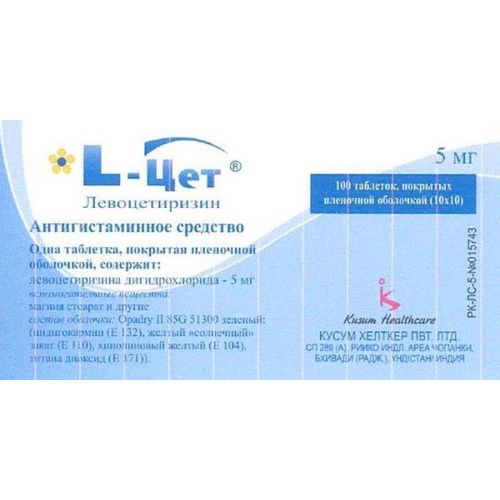
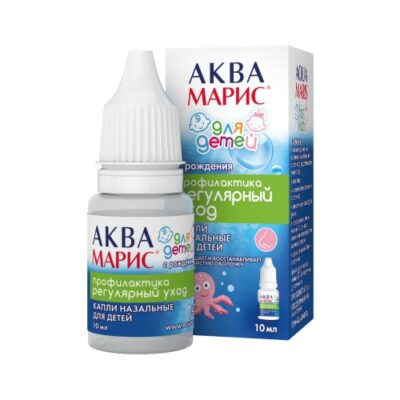
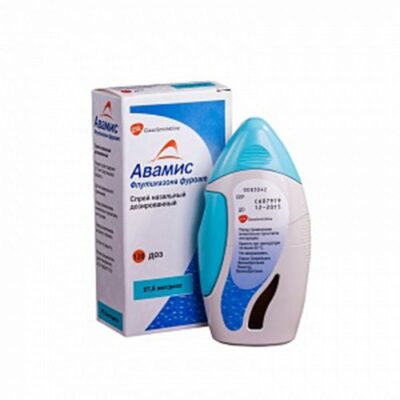
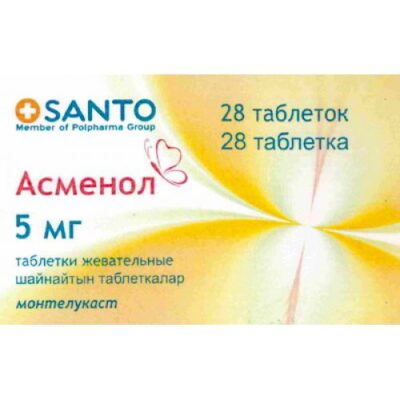
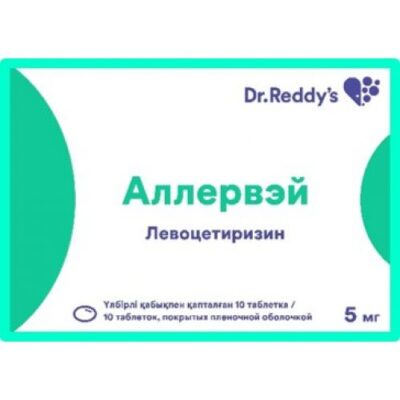
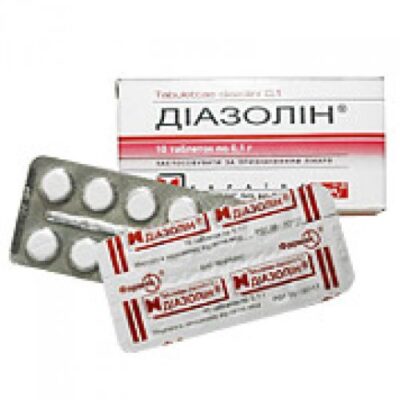
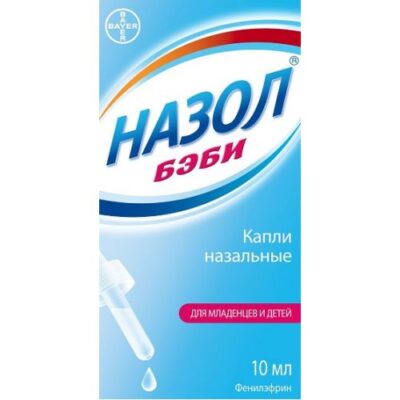
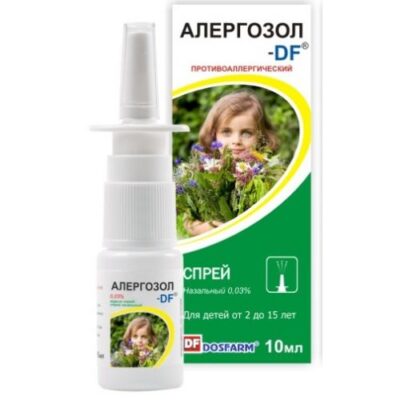
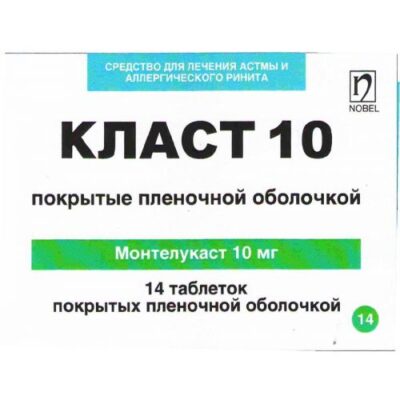
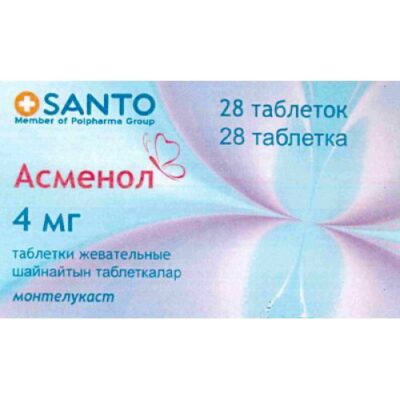
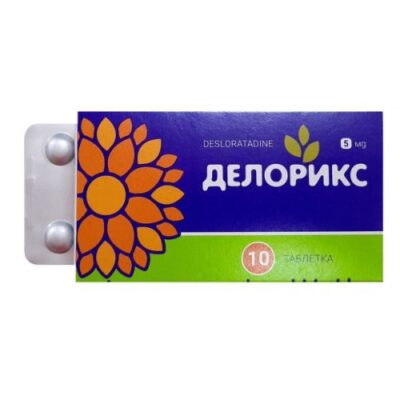






Reviews
There are no reviews yet.